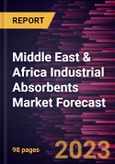Growing Environmental Concerns Concerning Chemical and Oil Spills Drives Middle East & Africa Industrial Absorbents Market
Oil spills are long-lasting environmental disasters with a wide range of impacts. The effects of oil spills can vary, ranging from minimal to serious ones, depending on the magnitude and location of the spillage. Oil can kill surface-dwelling animals and birds by poisoning or suffocating them, or by affecting their buoyancy and natural waterproofing mechanisms. Contaminated food supplies may lead to the malnourishment of animals, which may be followed by poisoning over time. The damage can be significant if an oil spill happens in an area with wildlife. Oil disables the insulating ability of fur on mammals and impacts the water-repelling qualities of a bird's feathers. Without insulation or water-repelling qualities, mammals and birds can die from hypothermia. Further, oil and oil products (petroleum products) have many volatile compounds that are emitted as gases. These gases or volatile oil products contaminate the surrounding air, producing specific odors. Even when odors are not felt, exposure to these compounds for a prolonged period may lead to health risks among the living organisms present in these surroundings. Moreover, once in the air, contamination may travel over long distances. The original contamination levels at the source and specific weather conditions may dictate the final spread of oil-contaminated air vapors. Oil spills, leading to oil slicks and sheens, also harm the aesthetic appeal and recreational value of coastal waters, shorelines, beaches, wetlands, etc. Serious consequences include the discontinuation of recreational activities in these areas, at least temporarily, until the spill is removed, and the cleanup process is completed. The effects of oil spills are not only limited to the environment. The incidences may have immediate effects on humans, fish, animals, birds, and wildlife, in general, if they come in direct contact with the spilled oil, breathe in volatilized oil components, consume food contaminated at any level in the food chain, and so on. Therefore, growing concerns about the environment and the associated regulations to prevent oil spills bolster the demand for industrial absorbents across the region.Middle East & Africa Industrial Absorbents Market Overview
The Middle East & Africa (MEA) primarily includes South Africa, Saudi Arabia, and the UAE. The growth of the Middle East & Africa industrial absorbents market is attributed to the high demand for industrial absorbents from industries such as oil & gas, food processing, healthcare, automotive, and chemical. The automotive industry in South Africa is the most important manufacturing industry in the region. Further, the oil & gas industry includes various hazards, including oil spills, which increase the need for industrial absorbents. The Middle East & Africa region includes many oil-producing countries such as Saudi Arabia, Iraq, the UAE, Iran, and Kuwait. The strong presence of the oil & gas sector in the region creates a huge demand for industrial absorbents. Further, the growth of chemical, food processing, and healthcare industries provides lucrative opportunities for the Middle East & Africa industrial absorbents market growth.Middle East & Africa Industrial Absorbents Market Revenue and Forecast to 2028 (US$ Million)
Middle East & Africa Industrial Absorbents Market Segmentation
The Middle East & Africa industrial absorbents market is segmented into product type, type, end-use industry, and country.Based on product type, the Middle East & Africa industrial absorbents market is segmented into pads, rolls, pillows, booms, socks, and others. In 2022, the booms segment registered a largest share in the Middle East & Africa industrial absorbents market.
Based on type, the Middle East & Africa industrial absorbents market is segmented into universal, oil-only, and hazmat/chemical. In 2022, the hazmat/chemical segment registered a largest share in the Middle East & Africa industrial absorbents market.
Based on end-use industry, the Middle East & Africa industrial absorbents market is segmented into oil and gas, chemical, food processing, healthcare, automotive, and others. In 2022, the oil and gas segment registered a largest share in the Middle East & Africa industrial absorbents market.
Based on country, the Middle East & Africa industrial absorbents market is segmented into South Africa, Saudi Arabia, the UAE, and the Rest of Middle East & Africa. In 2022, Saudi Arabia segment registered a largest share in the Middle East & Africa industrial absorbents market.
3M Co, Ansell Ltd, Brady Corp, Decorus Europe Ltd, and Tolsa SA are the leading companies operating in the Middle East & Africa industrial absorbents market.
Table of Contents
Companies Mentioned
- 3M Co
- Ansell Ltd
- Brady Corp
- Decorus Europe Ltd
- Tolsa SA
Table Information
| Report Attribute | Details |
|---|---|
| No. of Pages | 98 |
| Published | June 2023 |
| Forecast Period | 2022 - 2028 |
| Estimated Market Value ( USD | $ 464.43 million |
| Forecasted Market Value ( USD | $ 586.37 million |
| Compound Annual Growth Rate | 4.0% |
| Regions Covered | Africa, Middle East |
| No. of Companies Mentioned | 5 |









